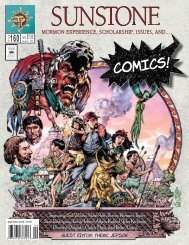is there a place for heavenly mother in mormon theology?
is there a place for heavenly mother in mormon theology?
is there a place for heavenly mother in mormon theology?
You also want an ePaper? Increase the reach of your titles
YUMPU automatically turns print PDFs into web optimized ePapers that Google loves.
S U N S T O N E<br />
they are the m<strong>is</strong>takes of men.<br />
UNDERSTANDING THE<br />
VIOLENT SACRED<br />
By Mack C. Stirl<strong>in</strong>g<br />
IN 2 SAMUEL 21, WE READ THAT ANCIENT ISRAEL<br />
under K<strong>in</strong>g David was experienc<strong>in</strong>g three years of fam<strong>in</strong>e.<br />
The Lord was consulted, and he <strong>in</strong><strong>for</strong>med David that the<br />
fam<strong>in</strong>e was a result of blood guilt on the land. The blood guilt<br />
had been caused one or two generations earlier by K<strong>in</strong>g Saul’s<br />
reckless slaughter of the Gibeonites. In the story, David then<br />
goes to the Gibeonites to ask what can be done to assuage the<br />
blood guilt and reverse the fam<strong>in</strong>e. The Gibeonites suggest<br />
that seven of the descendants of Saul be killed and exposed<br />
“be<strong>for</strong>e the Lord.” Th<strong>is</strong> amounts to human sacrifice. David<br />
complies with th<strong>is</strong> request and ritually kills seven of Saul’s<br />
grandsons. Afterwards, the ra<strong>in</strong>s come, end<strong>in</strong>g the fam<strong>in</strong>e.<br />
Th<strong>is</strong> text presents the Lord as a violent and capricious deity<br />
who personally pun<strong>is</strong>hes Israel dur<strong>in</strong>g the time of David <strong>for</strong><br />
earlier s<strong>in</strong>s of K<strong>in</strong>g Saul. The Lord retracts th<strong>is</strong> pun<strong>is</strong>hment<br />
only when offered sufficient sacrificial victims. I am personally<br />
appalled by such a god and have no desire to get close to him.<br />
Furthermore, I simply cannot harmonize th<strong>is</strong> bloodthirsty god<br />
with my own personal experiences of God’s lov<strong>in</strong>g grace, nor<br />
with the New Testament.<br />
When <strong>for</strong>ced to confront such problematic biblical texts,<br />
Latter-day Sa<strong>in</strong>ts commonly respond <strong>in</strong> one of two ways. The<br />
first <strong>is</strong> to suggest that the text may have been “translated” <strong>in</strong>correctly<br />
and, <strong>there</strong><strong>for</strong>e, may be ignored. The second <strong>is</strong> to attempt<br />
to justify or rationalize the violent actions of God as acts<br />
of love. I <strong>in</strong>s<strong>is</strong>t that both these k<strong>in</strong>ds of responses are unsat<strong>is</strong>factory<br />
and <strong>in</strong>adequate. Instances of capricious div<strong>in</strong>e violence<br />
are simply too numerous and too pervasive to be ascribed to a<br />
MACK C. STIRLING, M.D., <strong>is</strong> director of cardiothoracic<br />
surgery at Munson Medical Center <strong>in</strong> Traverse<br />
City, Michigan, and <strong>is</strong> a member of the Dialogue<br />
Foundation board of directors. Th<strong>is</strong> paper <strong>is</strong> drawn<br />
from remarks given as part of the panel d<strong>is</strong>cussion, “The Bible,<br />
Violence, and the Sacred: An Overview of the Thought and<br />
Significance of René Girard,” at the 2003 Salt Lake Sunstone<br />
Symposium (tape SL03–132).<br />
translation problem. Furthermore, many <strong>in</strong>stances of div<strong>in</strong>e<br />
violence simply cannot be justified by any reasonable means.<br />
The story from 2 Samuel, with which I began, <strong>is</strong> an excellent<br />
example.<br />
How do we use the Bible profitably to know God <strong>in</strong> the face<br />
of contradictory biblical portrayals of h<strong>is</strong> nature? Do we ignore<br />
the parts of the Bible we don’t like or understand? Do we<br />
simply wait <strong>for</strong> more canonized scripture? I f<strong>in</strong>d neither approach<br />
sat<strong>is</strong>factory. To put a sharper po<strong>in</strong>t on the problem,<br />
compare the God of the Flood with the Lord of the Gospels.<br />
We, of course, consider them to be the same person, Jesus<br />
Chr<strong>is</strong>t. In the Flood, God became grieved at the violent s<strong>in</strong>s of<br />
the human race and responded by violently kill<strong>in</strong>g nearly all<br />
humanity <strong>for</strong> their s<strong>in</strong>s. Now, contrast th<strong>is</strong> with the Lord Jesus<br />
of the Gospels. Th<strong>is</strong> God allowed men to kill Him <strong>for</strong> their s<strong>in</strong>s<br />
<strong>in</strong> order that they might be enabled to turn out of their s<strong>in</strong>s.<br />
There <strong>is</strong> a radical d<strong>is</strong>junction between the nature of the God<br />
of the Flood and the Jesus of the Gospels. I do not believe th<strong>is</strong><br />
d<strong>is</strong>junction can be solved by appeals to m<strong>is</strong>translation, nor by<br />
attempts to construe the Flood as an act of love, nor by assertions<br />
that God treated mank<strong>in</strong>d differently under the “lesser<br />
law” of the Old Testament. No, these are not sat<strong>is</strong>factory answers.<br />
IBELIEVE RENÉ GIRARD can help. Girard <strong>is</strong> a recently retired<br />
professor of French language and civilization at<br />
Stan<strong>for</strong>d University who through extensive study of the<br />
major Western cultural texts—especially <strong>in</strong> literature, anthropology,<br />
psychology, and biblical studies—has developed a<br />
wide-rang<strong>in</strong>g theory of culture. To understand Girard’s approach<br />
to th<strong>is</strong> d<strong>is</strong>junction between the Old and New<br />
Testament God, one must grasp two th<strong>in</strong>gs: (1) Girard’s concept<br />
of the violent sacred and (2) h<strong>is</strong> understand<strong>in</strong>g of the<br />
cross. 1<br />
The Violent Sacred. For Girard, the orig<strong>in</strong> of the violent sacred<br />
lies <strong>in</strong> the collective action of human be<strong>in</strong>gs. From h<strong>is</strong><br />
JULY 2004 PAGE 33
















